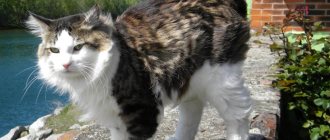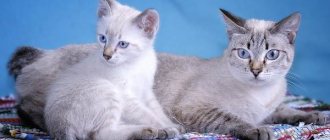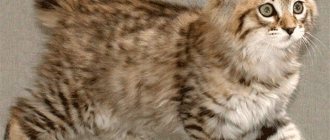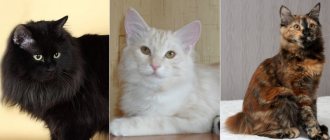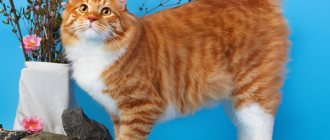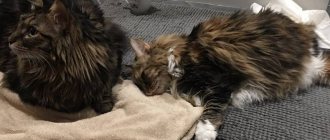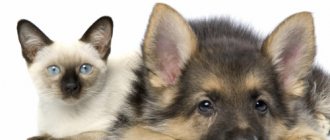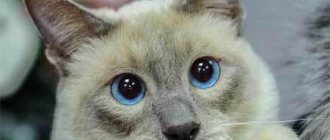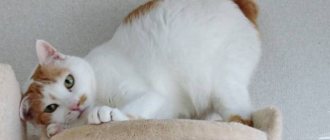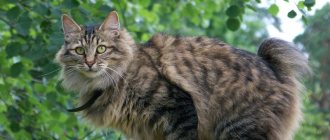At first glance, it may seem that a cat with a short tail is the result of human actions. However, the bobtail is a native animal and its small tail is the result of the intervention of Mother Nature herself. The tail of these interesting cats is the subject of discussion among many cat lovers, and owners of any type of bobtail are ready to talk about them endlessly. It is believed that each short ponytail has only its own, individual, unique features; if you describe each ponytail in detail, it turns out that each of them is unique.
Common signs of bobtail cats
There are several types of bobtail cats on earth today. They are all united according to several main characteristics:
- A short small tail measuring approximately 2 to 12 centimeters;
- Sufficiently long (longer than the front) and strong hind legs;
- Quite a low timbre of voice;
- No need to mark territory (unless two competing cats live in the same apartment);
- Muscular physique.
It is also worth noting the special character that distinguishes all cats of the breed: they are all fearless, well adapted to life in the wild, and able to stand up for themselves. But at the same time they have a devoted, almost dog-like heart. They become attached to the owner, and not to the place, they love him with all their cat soul. They lend themselves very well to classical training, the “fetch” command is easy to execute, and these amazing cats feel quite comfortable on walks, even if the owner walks his pet on a leash.
Health
Bobtails have fairly good health. Currently, no genetic diseases have been identified. However, some breeders note that the absence of a tail can be the cause of inflammatory processes in the anus and rectal prolapse. Therefore, it is extremely important to periodically examine the animal for redness or cracking in the anus. Otherwise, all types of bobtails require the usual preventive vaccinations and antiparasitic measures for any cat.
The life expectancy of bobtails is quite high. They live for about 15 years, but with proper care they can live longer.
The longest-livers among bobtails, and cats in general, are Mekongs. Their lifespan is 20–25 years.
Kurilian Bobtail
Kurilian bobtails, true to their name, were found in the wild on the Kuril Islands. The place of residence influenced the appearance and physique of the smoker. The cat is distinguished by a rather severe-looking appearance: medium-length thick hair, a large head, wide cheekbones, a muscular, well-developed body, ears tilted forward, an arched back and a croup slightly raised due to the long hind limbs.
In the wild, a cat obtains food on its own, is an excellent rodent hunter, and an excellent fish catcher. Colors can be varied, with only a few species being exceptions to the standards. The tail of the Kurilian Bobtail cannot be straight. A straight tail is considered a breed defect, either very short or long (longer than 12 centimeters).
Despite its completely wild appearance, at home, a representative of this breed is an extremely friendly, affable, devoted animal. He loves affection, but not at the request of the owner, but only at his own request.
Does not tolerate coercion, violently protests against forced hugs or stroking.
But, having approached for a portion of the owner’s tenderness, he hopes to receive it in full, even with too much. He will never climb into his arms, but with pleasure he will lean back against his owner’s leg, he will purr in his gut, demonstrating in every possible way his complete pleasure. If a Kuril short-tailed cat lives in the house, there will never be mice or rats there; the Kuril will hunt until it has eliminated all the rodents in its possessions.
Hybrid breeds
During breeding work, several more breeds of cats with short tails were developed.
Pixiebob
The result of crossing a wild lynx and a short-haired cat. Animals are highly talkative, so you need to be prepared for constant rumbling, purring and chattering under the ear. Cats love to be the center of attention and follow their owner wherever he goes and whatever he does. They feel great outside the home, going with the family on picnics or long journeys. They can walk on a leash and follow some commands. Pixiebobs have high intelligence, which gives them a head start in many games - both active and static. They get along well with children, but you need to make sure that they treat the cat with due respect and do not offend it.
On average, animals live 13-15 years and have no predisposition to hereditary diseases.
Karelian Bobtail
The Karelian bobtail is smaller in appearance and more graceful than the Kurilian. His head is more elongated, shaped like a triangle, his muzzle is quite narrow, there are no cheeks, there are only slightly convex whisker pads. The ears are large and vertical; the outer line of the ear seems to continue with the line of the head. Karelians come in short-haired and medium-haired varieties. The tail is from 4 to 13 centimeters. An individual distinctive feature of this type of bobtail: the hair on the tail is always longer than on the entire body, which is why the pom-pom effect occurs. Also, the Karelian tail can be straight, and not just broken. Unlike the Kurilian bobtail, the Karelian has a straight back without an arch. The types of colors are very numerous, the exceptions are exactly the same as for the Kurilian Bobtail.
The character of this short-tailed handsome man is very friendly and accommodating. In their natural environment, Karelian cats live in a pride, like lions, so they are simply forced to find a common language with all their neighbors.
The quality of the voice is amazing.
This cat sings as if a taiga bird is singing; experts from Germany even call Karelians “Tweeting cats.”
This cat will never yell at its owner if he needs something. But demonstrating your desire by gently touching it and then showing the direction of movement is very easy.
The history of the appearance of tailless cats
All tailless cats, with the exception of hybrids and pixie-bobs, are the result of natural mutation that occurred in limited geographic ranges. Depending on the place of origin, they are divided into 2 groups:
- Manx cats born in the British Isles;
- bobtails that appeared on the territory of Japan, which for a long time led a predominantly closed lifestyle.
The relationship of these animals has not been proven, but it has not been disproved either. One part of felinologists is inclined to the theory of parallel and separate development of each of the groups, and the second - to the theory of the movement of “mustaches” from one area to another along with people.
INTERESTING!
According to one legend, the bobtailedness of cats is due to the slowness of their distant ancestor, who jumped into Noah’s Ark at the very last moment. Because of this, the closing door pinched his tail.
British breeds
The first mention of cats without a tail dates back to the mid-18th century. Representatives of this group appeared on the Isle of Man, located between Great Britain and Ireland. Local breeders quickly fixed the mutation in new generations, arousing great interest among breeders from Europe and America.
In appearance, Manx cats resemble the classic chubby-cheeked “British”. Most of them have short hair, but in Canada there is also a separate long-haired variety.
Japanese breeds
In Japan, bobtails are called maneki-neko, or “alluring cat.” Ceramic and porcelain figurines with their image are often displayed in shop windows, restaurants and other establishments in order to attract good luck. Despite the modern reverence for cats without a tail, the alleged history of their appearance is rather dark and sad.
The Japanese believed that in old age, domestic cats turned into nekomata - dangerous demons (youkai) that kidnapped and ate people. A distinctive feature of these creatures was their forked tail, so enterprising owners began to cut it off for their pets in childhood.
The systematic destruction of the long tail led to a genetic mutation. Kittens with a fluffy pompom began to appear, so the breeders just had to secure its inheritance.
Japanese Bobtail
This cat is large (can weigh up to 14 kilograms), has an athletic build, a fluffy short tail and an appearance full of grace and elegance. According to ancient Japanese legend, a cat's tail is a repository of troubles, sorrows and vices. Accordingly, the absence of a tail in a cat entails all sorts of joy, happiness and prosperity. In Japan, Japanese bobtails, specifically cats, are called Maneki Neko (Hello Cat), in images the cat often has its front right paw raised up, as if in greeting, and also has a cute fluffy tail of a chrysanthemum-like appearance.
If this cat is frozen in some pose, then she clearly looks like a porcelain figurine, her coat is so neat, just hair to hair. The color, like many bobtails, can be any color (again, with the exception of just a few colors), but tortoiseshell colors with fiery red elements and white spots are traditional. Old descriptions of the breed give an idea of Japanese short-tailed cats as white cats with spots of red and black (mi-ke). It is believed that the white Japanese bobtail is a carrier of the gene for different eyes, the color of one is blue, the other is golden.
The Japanese have a distinctly triangular head, a long nose, and a clearly defined jawline. Well-drawn cheekbones protruding forward, high-set wide ears with small interesting tassels, large round eyes.
The Japanese Bobtail cat is curious, very active, tactful, and easy to communicate with. Energy simply pours out of all their limbs. This cat, if deprived of its movement, begins to show an explosive character, demonstrate dissatisfaction and misbehavior in every possible way.
Therefore, the cat is recommended to be kept with active families; she is simply prescribed long walks on a leash, active games with all sorts of moving and hanging toys.
It is advisable for owners to acquire scratching posts and special cat climbing frames. In gratitude for this, the owner will receive a cheerful, smart, active friend who can keep company on a walk, become a reliable playmate for children, a universal favorite and spoiled child. Japanese cats really do not like loneliness, do not tolerate it well, and yearn for human society.
How to choose a kitten
Purchasing a Kurilian Bobtail kitten is a responsible step that requires intuition and attentiveness from you! It is important to notice among the frolicking kittens exactly the one who will catch your heart. At the same time, you should not listen to either the words of the breeder or the advice of friends and relatives: this is your pet, so you only need to rely on your own premonitions.
The ideal age for purchasing a Kurilian Bobtail is three months. It is at this time that the baby begins to show independence and gradually weanses the habit of maternal care. In addition, a three-month-old “smoker” already has fairly balanced psychological health, so he quickly gets used to new family members.
If the pedigree of the future pet plays an important role, ask the breeder to introduce you to the necessary documentation or, more preferably, to the parents of the babies. This is one of the easiest ways to understand what to expect from your bobtail. The breeder is not talkative and does not demonstrate a desire to tell as much as possible about his charges? This is an alarming sign: it means he has something to hide from curious and persistent buyers like you.
When choosing a kitten, you should focus on its behavior among its brothers. Is your baby active and cheerful, happily getting involved in play and showing healthy curiosity towards you? This is your pet! Refrain from buying lethargic and timid kittens: this may lead to unpleasant consequences in the future.
American Bobtail
The American Bobtail cat breed (also called Yankeebob) is not related to other short-tailed breeds. They originated in America as a result of a gene mutation that turned into the highlight of the breed. The American Bobtail is a fairly large animal with a powerful body and a developed chest. The American has a flat back, with relief of the shoulder blades, which protrude slightly, and the paws are large, muscular, and round in shape. A square, wide head with prominent cheekbones, a clearly defined forehead, a strong chin, a medium nose, medium ears set wide with rounded tips. The coat can be either short or long, of any color.
The American cat has a very good-natured character, he is a wonderful companion, a loyal friend and a very smart pet with some dog-like habits. He will gladly bring his owner a toy or prey in the form of a caught mouse, but will never refuse to lie in the arms of any family member, while he will purr loudly and generally demonstrate in every way how happy he is, being in the company of a gentle, caring comrade .
What to feed and pamper
For short-tailed cats, natural or high-quality dry food is preferable. A large amount of hard and hard food is desirable in the diet: bones, chicken stomachs and cartilage.
Feeding a cat raw, clean meat is dangerous; it is better to combine fresh chicken, fish with dry food. Your pet's bowl should always be filled with unboiled water.
Brave and courageous bobtails will become a devoted friend for a person and even an excellent nanny for small children.
Siberian cat - history of the breed, description, character and habits + 95 photosOriental cat - history of the breed, modern standards, character, care, nutrition + 83 photos
- Maine Coon - history of occurrence, description of the breed, character + 84 photos
With their boundless affection, they are more like a purring dog: they are also faithful, do not leave their home without their owner and follow on his heels everywhere.
Mekong (Thai) Bobtail
The Mekong Bobtail (the old name of the Thai Bobtail breed) is a cat whose origin is covered in the legend of the sacred Thai animal. These cats existed back in the days when countless and innumerable treasures were kept in the Buddhist temples of Ancient Siam. These cats guarded the Siamese princesses, accompanying the beauties everywhere. While bathing, Thai high-ranking girls took off their jewelry and hung their guard cats on the broken and twisted short tails, from which they could not fall and get lost.
Mekong Bobtail cats resemble their Siamese friends: the same wedge-shaped head, only with rounded shapes, the same slanting large almond-shaped eyes of a piercing blue color. And, most importantly, it is a unique color-point color of various species.
The hind legs of this type of bobtail have a distinctive feature - the claws on them do not retract inside the pads, so a light tapping sound is heard when walking.
A characteristic behavioral feature of the Mekong Bobtail is a clear imitation of dog manners. This doesn't just show up in games. During a walk, the cat will behave completely like a dog: walk next to the owner, demonstrating complete obedience, and in case of danger, he will certainly rush at the offender.
But during the breeding and raising of offspring, an amazing distribution of responsibilities will be observed, not typical of other breeds. After giving birth to kittens, a bobtail cat feeds the babies and minimally cares for them. But the cat takes on the main functions of raising the heirs: he licks them, teaches them all sorts of wisdom and behaves like a real father of the family. In addition, the Mekong Bobtail cat, having created a family with a cat, behaves completely atypically for cats; he remains faithful to his cat, unless a person forces him to mate with another partner.
Breeding
To knit bobtails, you should adhere to the following recommendations:
- At the time of mating, the cat should be in 1-2 heats. Moreover, she should not be younger than 1 year, since before this period her body is not yet fully formed. The cat must also be at least 1 year old. The optimal age is one and a half years.
- At least one partner must already be experienced in this matter, so that the mating is not disrupted by the confusion of both animals.
- Both partners must be healthy, vaccinated and dewormed 14 days before this day.
- You should not wash the cat before mating, so as not to deprive her of the natural smell that attracts the cat so much.
- The meeting should be scheduled on the cat’s territory so that he feels like a master and does not waste time adapting.
- Mating is prescribed on the 2nd–3rd day of estrus. The cat should be left with the cat for 3-5 days.
The peculiarity of bobtails is that they are prohibited from crossing with cats of other breeds. You should also keep in mind that when choosing a partner, you need to pay attention to the length of his tail. If a cat’s tail reaches 8–12 cm in length, then a cat’s tail should be much shorter - this results in offspring with a tail from 3 to 8 cm.
Typically, pregnancy and childbirth proceed without any special features. But if the owner is inexperienced, it is better to play it safe and invite a veterinarian to attend the birth.
Other types of bobtails
Oriental Bobtail - bred in Great Britain, is experimental, named after the oriental color.
Snow Bob - also got its name because of its color, reminiscent of the Alaskan lynx.
Oohee-bob - obtained as a result of mating a Siamese cat and a Manx (tailless cat), has a bi-color or color-point color.
The toy bobtail has a toy size, like a kitten, and absolutely childlike mischievous behavior.
Varieties by tail length
The tail of the most common “moustache” consists of 20-26 caudal vertebrae. With mutation, this amount decreases sharply. Depending on the final length, the following varieties are distinguished:
- rampi – 0 vertebrae;
- riser – 1-3 vertebrae, noticeable only with short hair;
- Stumpy – 4-8 vertebrae;
- longs, or tails, are close to the usual ones.
In cats without tails, the last 2 options are considered disadvantages. For show breeds, the preferred length is within 4 cm. Longer varieties are accompanied by tuberosity and knobbiness.
Photo
Care
Caring for a bobtail is easy. Brushing once or twice a week is necessary to keep the coat smooth and healthy. The brush should be selected based on your pet's coat type. Remember to trim your nails regularly and check and clean your ears regularly in the morning.
The Bobtail is a relatively low-energy breed and does not require much exercise. Owners don't have to go out of their way to get these cats moving, but one-on-one play can be encouraged and appropriate toys offered.
Because they are intelligent, these cats can be easily trained to perform simple tasks such as using a litter box or scratching post. They can also be taught to play games like “Fetch!” and walk on a leash.
Socialization with this good-natured breed should be easy. Bobtails who are introduced early to people and pets usually get along easily and greet unfamiliar faces.
All types of bobtails should be fed cat food recommended by a veterinarian. It is important not to overfeed your cat, as this can lead to obesity.
Please note ⭐⭐⭐
Burmese cat - photo of the sacred cat, pet care and keeping at home (110 photos)
British shorthair cat - features of cat care, its colors, selection of proper nutrition (110 photos)
Ragdoll - 120 photos, description of appearance and color, her character, how she gets along with other pets
